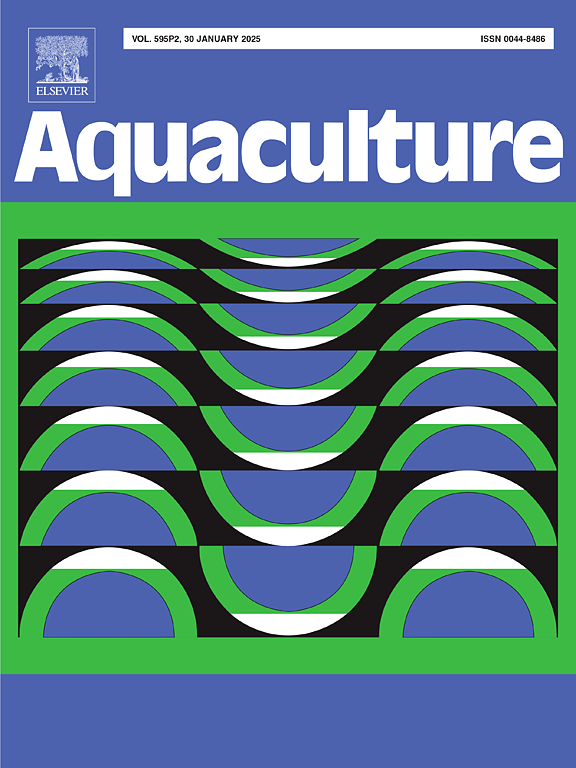A granulocyte highly-expressed α2 adrenergic receptor promotes the expression of IL-17 and TNFs in the immune response of oyster Magallana gigas
IF 3.9
1区 农林科学
Q1 FISHERIES
引用次数: 0
Abstract
Catecholamine, along with adrenergic receptor (ARs), plays a pivotal role in mediating the immune function of vertebrates under stressful environment. However, the immunomodulatory role of adrenergic receptors in invertebrates remains largely unknown, hindering the development of effective stress management strategies in invertebrate aquaculture. In the present study, an α2 type adrenergic receptor, designated as Mgα2AR, was identified in an economically important species, the Pacific oyster Magallana gigas. The Mgα2AR was consisted of seven transmembrane domains and one short carboxyl terminus. The mRNA transcript of Mgα2AR was expressed in haemocytes and all the examined tissues, with the highest expression level in haemocytes, particularly in granulocyte (9.28-fold of that in agranulocyte, p < 0.05). By immunofluorescence analysis, Mgα2AR was found primarily localized in the cytoplasmic membrane of granulocytes. The mRNA expression of Mgα2AR in haemocytes increased significantly at 6 h, and peaked at 12 h (4.71-fold of that in control group, p < 0.01) after LPS stimulation in vivo. After transfection and expression of Mgα2AR in HEK293T cells, a significant decrease in cAMP concentration, rather than in Ca2+ concentration, was observed upon treatment with the agonist NE (p < 0.05), while the administration of the α2 adrenergic receptor antagonist (Ida) yielded opposite results. The expressions of MgIL17–5, MgTNF-1, and MgTNF-2 in oyster haemocytes were also downregulated following treatment with α2AR antagonist Ida, which was 0.44-fold, 0.54-fold, and 0.32-fold of that in the NE+ LPS group (p < 0.01), respectively. After Mgα2AR was knockdown by RNAi, the transcripts of MgIL17–5, MgTNF-1, and MgTNF-2 significantly decreased. These results collectively suggested that the granulocytes highly-expressed Mgα2AR could induce the expressions of TNFs and IL-17 by reducing the intracellular cAMP level in the immune response of oysters. These findings provide a novel insight into the immunomodulatory role of adrenergic receptors in mollusks, and also offer valuable information for the development of effective stress management strategies in aquaculture.
粒细胞高表达的α2肾上腺素能受体可促进牡蛎免疫反应中 IL-17 和 TNFs 的表达
儿茶酚胺和肾上腺素能受体(ARs)在应激环境下调解脊椎动物的免疫功能方面发挥着关键作用。然而,肾上腺素能受体在无脊椎动物中的免疫调节作用在很大程度上仍不为人所知,这阻碍了在无脊椎动物养殖中制定有效的应激管理策略。本研究在具有重要经济价值的物种--太平洋牡蛎(Magallana gigas)中发现了一种α2型肾上腺素能受体,命名为Mgα2AR。Mgα2AR 由七个跨膜结构域和一个短的羧基末端组成。Mgα2AR 的 mRNA 转录本在血细胞和所有受检组织中均有表达,其中在血细胞中表达水平最高,尤其是在粒细胞中(是粒细胞的 9.28 倍,p < 0.05)。免疫荧光分析发现,Mgα2AR主要定位于粒细胞的细胞质膜。体内 LPS 刺激后,血细胞中 Mgα2AR 的 mRNA 表达量在 6 h 显著增加,并在 12 h 达到峰值(是对照组的 4.71 倍,p < 0.01)。在 HEK293T 细胞中转染和表达 Mgα2AR 后,在使用激动剂 NE 处理时,观察到 cAMP 浓度显著下降,而不是 Ca2+ 浓度显著下降(p < 0.05),而使用 α2 肾上腺素能受体拮抗剂(Ida)则产生相反的结果。α2AR拮抗剂Ida处理后,牡蛎血细胞中的MgIL17-5、MgTNF-1和MgTNF-2的表达也被下调,分别是NE+ LPS组的0.44倍、0.54倍和0.32倍(p <0.01)。通过 RNAi 方法敲除 Mgα2AR 后,MgIL17-5、MgTNF-1 和 MgTNF-2 的转录物显著下降。这些结果共同表明,在牡蛎的免疫反应中,粒细胞高表达的Mgα2AR可通过降低细胞内cAMP水平诱导TNFs和IL-17的表达。这些发现为了解肾上腺素能受体在软体动物中的免疫调节作用提供了新的视角,也为制定有效的水产养殖应激管理策略提供了有价值的信息。
本文章由计算机程序翻译,如有差异,请以英文原文为准。
求助全文
约1分钟内获得全文
求助全文
来源期刊

Aquaculture
农林科学-海洋与淡水生物学
CiteScore
8.60
自引率
17.80%
发文量
1246
审稿时长
56 days
期刊介绍:
Aquaculture is an international journal for the exploration, improvement and management of all freshwater and marine food resources. It publishes novel and innovative research of world-wide interest on farming of aquatic organisms, which includes finfish, mollusks, crustaceans and aquatic plants for human consumption. Research on ornamentals is not a focus of the Journal. Aquaculture only publishes papers with a clear relevance to improving aquaculture practices or a potential application.
 求助内容:
求助内容: 应助结果提醒方式:
应助结果提醒方式:


